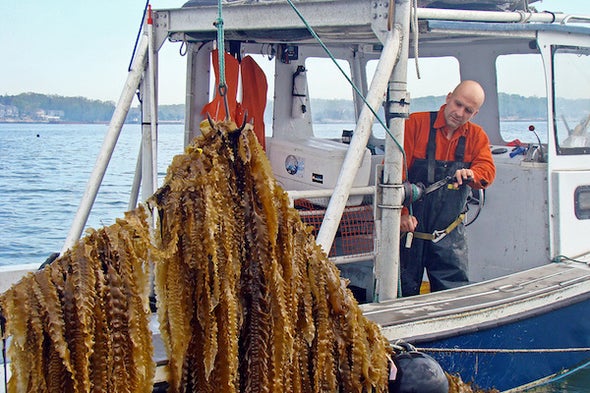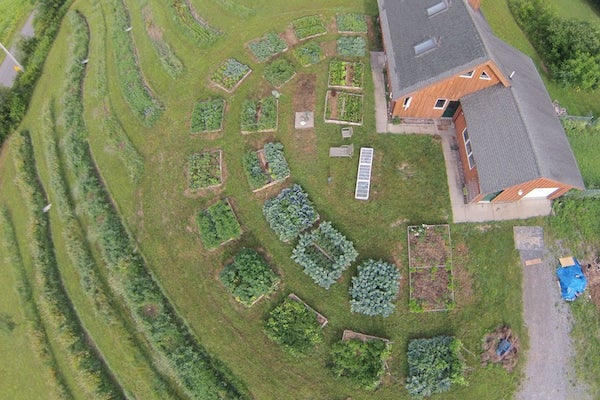We can sequester carbon and improve our nutrition through regenerative farming of land and sea
By Ayana Elizabeth Johnson, Louise Elizabeth Maher-Johnson on November 2, 2018

Scientists have issued a dire warning: to maintain a habitable planet we must dramatically reduce atmospheric carbon in the next decade. Nature has been warning us too, lately in the forms of climate change–intensifiedHurricanes Florence and Michael. Meanwhile, the Trump administration is freezing fuel-efficiency standards, propping up the coal industry, trying to roll back the Clean Power Plan and disbanding the Environmental Protection Agency’s scientific advisory boards.
In the absence of U.S. federal leadership on climate, what state, local, community or corporate solutions can be rapidly scaled? As a farmer and a marine biologist, and as mother and daughter, we have had two decades of dinner table conversations about the connections between agriculture and the ocean and about the alarming trends in soil health, ocean health and climate change. These discussions have converged on an underappreciated solution: regenerative farming of both land and sea. Put simply, regenerative goes beyond sustainable or organic, and actually restores soil and ocean health. This can put massive amounts of carbon back into soil and plants, while reducing use of pesticides and fertilizers, growing a cornucopia of healthy food and supporting local economies. Win-win-win-win.
On the terrestrial side, restoring our soils with regenerative practices (e.g., planting cover crops and perennials, eliminating monocultures and tilling) could sequester up to 60 tons of carbon per acre, increase crop productivity and improve nutrient uptake, water retention and pest resistance. Project Drawdown (an organization that analyzes and shares information on climate solutions), ranks regenerative farming as among the “greatest opportunities to address human and climate health, along with the financial well-being of farmers.”

Our soil is in serious need of restoration. The United States has lost around half of its topsoil since John Deere first started producing plows in the 1830s, and industrial agriculture has led to approximately 50 percentof soil carbon being released into the atmosphere. To quote soil geologist David Montgomery, “It only takes one good rainstorm when the soil is bare to lose a century’s worth of dirt.” And we’ve certainly been getting a lot of good rainstorms.
Hurricanes starkly show that agriculture, climate, human health and ocean health are deeply intertwined and that industrial agriculture is broken. Hurricane Florence caused massive lagoons of pig excrement to overflow and millions of chickens and pigs to drown. Rains wash waste, fertilizer, pesticides and topsoil into rivers and out to the sea, harming wildlife, disrupting the balance of nutrients and causing dead zones and blooms of toxic algae. Hurricanes are devastating, yet they are also a chance to consider how we rebuild.
.jpg)
Regenerative farming, as pioneered by the Rodale Institute and Regeneration International, can help us do away with pesticides. And not a moment too soon. For example, glyphosate, in Monsanto’s herbicide RoundUp, is an endocrine disruptor and toxin correlated with human diseases from diabetes and obesity, to breast and thyroid cancers, to stroke and autism. It can linger in seawater for over 10 months and may be exacerbating algal blooms. And the organophosphate group of pesticides stunt growth and harm reproduction of salmon, whales and other marine species, not to mention cause brain damage, with children especially at risk. As Rachel Carson wrote in Silent Spring, “It is not possible to add pesticides to water anywhere without threatening the purity of water everywhere.”
There is also plenty of room for improvement in how we farm the ocean. Far too much of the emphasis so far has been on fish. Farming fish requires lots of feed and can pollute waters with pesticides and antibiotics used to treat lice and disease, result in escapes that spread disease to nearby wild fish populations and generally require a lot of infrastructure and care. Improved feed options and technologies are addressing these drawbacks, but to focus on honing fish production is to miss a greater opportunity.
Regenerative ocean farming, as pioneered by Greenwave and others, means growing seaweed and shellfish (oysters, mussels, clams), not constructing more salmon farms. Seaweeds and shellfish don’t need to be fed; they grow with just sunlight and the nutrients and plankton already in seawater. As pioneering ocean farmer Bren Smith summarizes, “the real kicker” is that these low-maintenance ocean plants and animals “require no fresh water, no deforestation, and no fertilizer,” plus they improve water quality and create habitats for other species.
The ocean already absorbs around 40 percent of the carbon we release into the atmosphere (thank you, ocean), but because this is incorporated into seawater, that results in ocean acidification, which makes it harder for shellfish and corals to grow their shells and skeletons. But absorbing that carbon into plants via ocean farming and marine permaculture can provide healthy food while being a significant part of the climate solution. Kelp can grow over one foot or 30 centimeters a day! In fact, researchers estimate that if 9 percent of the ocean were dedicated to farming seaweed, that could remove 53 billion tons of CO2 from the atmosphere every year and restore pre-industrial levels of atmospheric carbon and reduce ocean acidification; plus there is the incredible potential for algae biofuels.
There’s a win-win on the ocean side too. When it comes to our health, seaweeds, aka “sea vegetables,” are a high-nutrient “superfood” we would do well to eat more of. Seaweeds are rich in protein, iodine and other minerals for which deficiencies are commonplace. We can also feed seaweed to livestock. Fun fact: Cows fed certain seaweed species belch 58 percent less methane, significant because methane is at least 34 timesmore potent a greenhouse gas than carbon dioxide. Even better, research shows that a diet containing shellfish has an even lower carbon footprint than being vegan. So ditch that factory-farmed bacon, and head to the nearest oyster happy hour.
As Missy Elliot raps, “flip it and reverse it.” Instead of continuing to rely on fossil-fuel–intensive manufacture of fertilizers, we can farm seaweeds that suck up carbon as they grow and can be used for food, biofuels and fertilizer. Instead of pesticides making us and the ocean sick, we can grow food in the ocean that makes us well. Instead of fertilizer runoff creating algal blooms, we can use algae as fertilizer to make fruit trees bloom. Instead of the U.S. farm bill supporting intensive monocultures that deplete soil, it should support restorative practices that rebuild soil.
Our atmosphere is overloaded with carbon, but carbon itself is not the enemy. From the stunning process of photosynthesis, to the transfer of energy in ecosystems, it is a vital element, the backbone of life. Through regenerative farming, soil and seaweed, we can draw down CO2 and feed ourselves while healing the planet. These are not cute, niche hippie concepts, but robust, scalable climate solutions that can feed the world.
It would be naive to expect Congress to use the 2018 farm bill as a moment to support a transition toward regenerative practices, instead of continuing to subsidize environmentally reckless farming. So we must turn to state and local emergency solutions to the climate crisis, including a return to the successful World War II victory gardens. Climate victory gardens, as proposed by Green America, would use regenerative practices to quickly convert lawns, public spaces and coastal waterways into carbon sponges and nutritious food. Everywhere there is space for a garden, every shoreline, and every person can be part of this fast, low-tech victory over our climate crisis.
Climate health is soil health is ocean health is human health. If we can muster the will before it’s too late, we can have our nutritious oysters and tomatoes and a livable climate too.












Đăng nhận xét